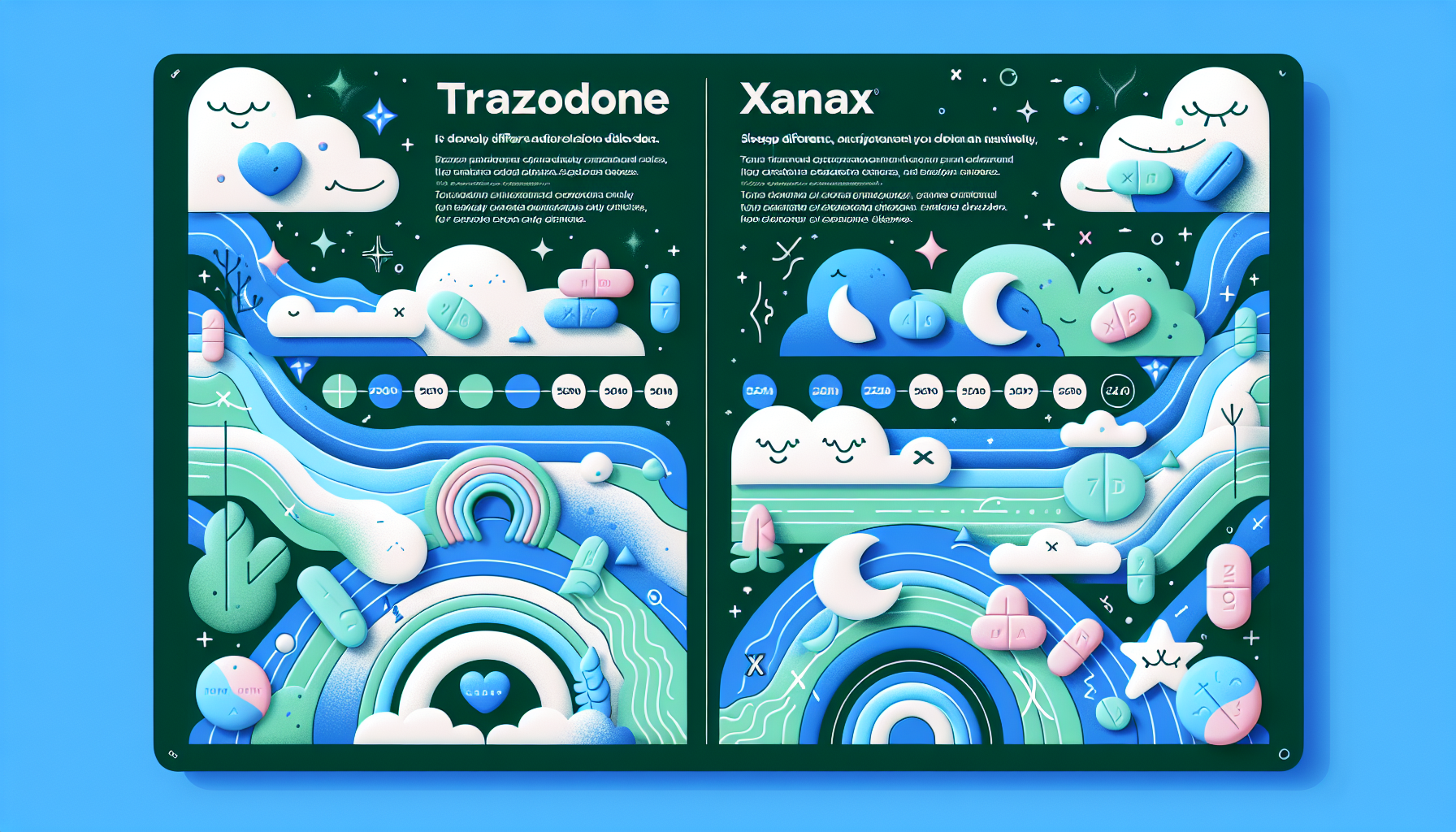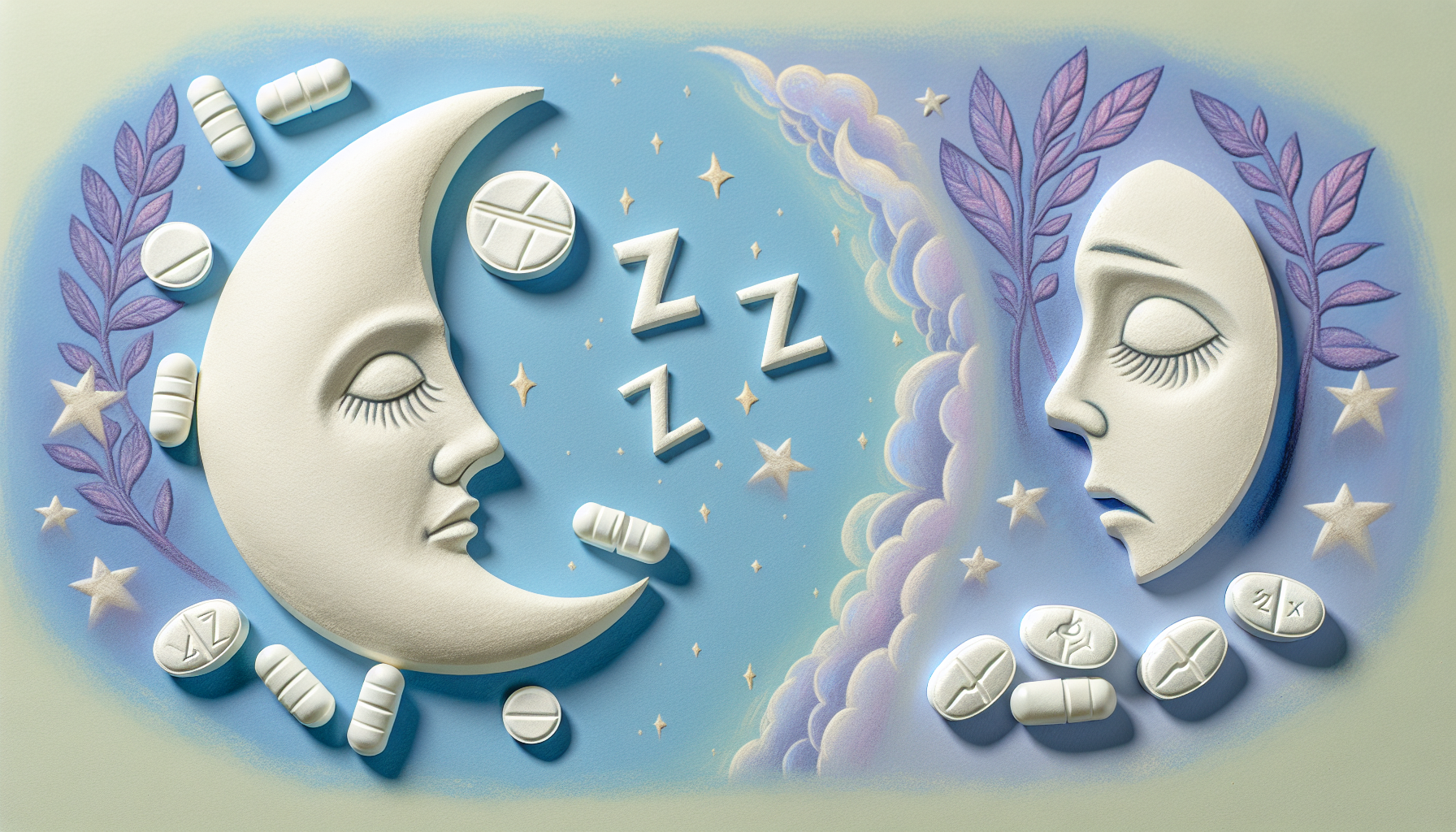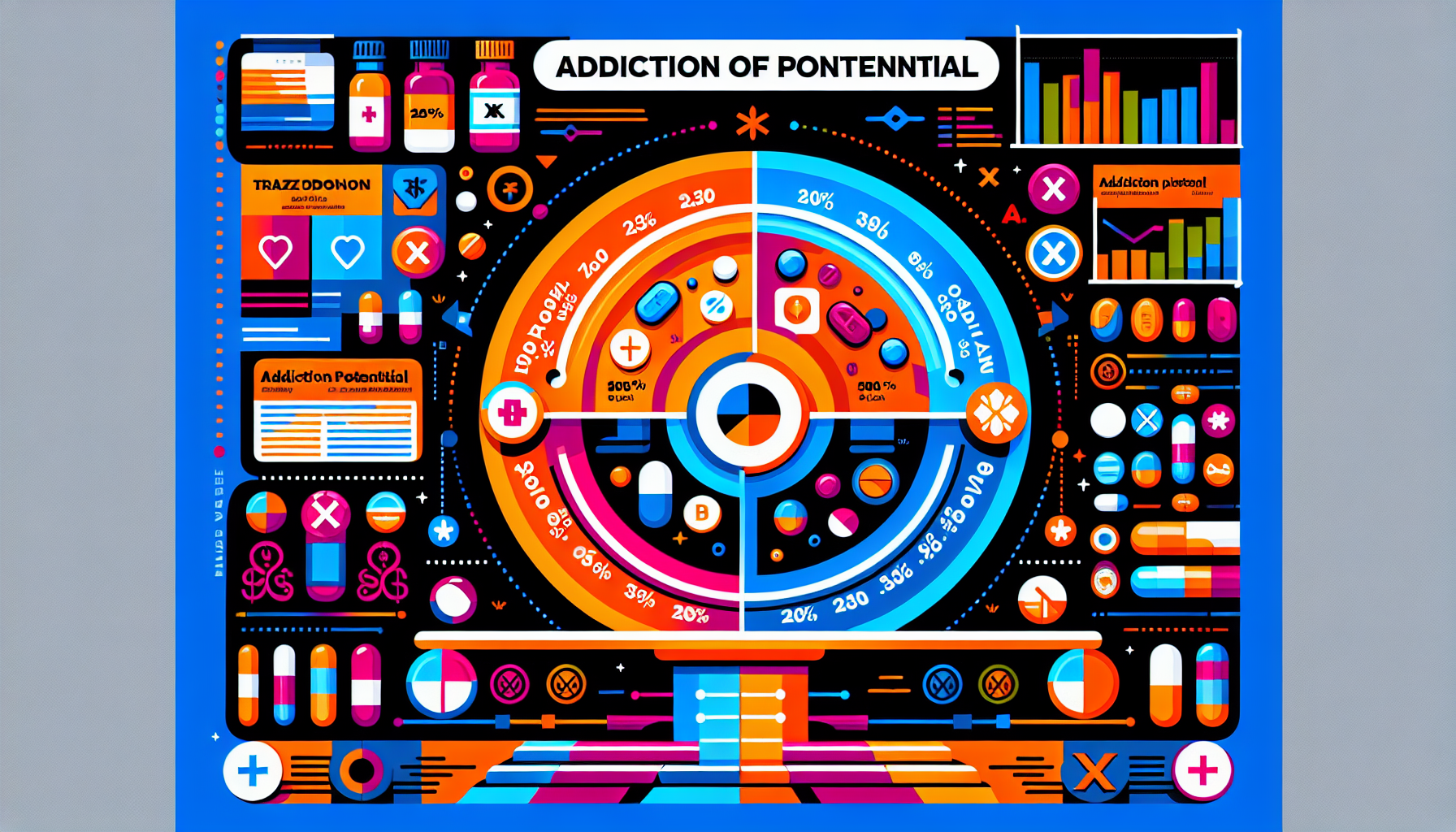Is Trazodone Similar to Xanax? Understanding the Key Differences
Is Trazodone similar to Xanax? While both are used for mental health issues, Trazodone and Xanax differ significantly. Trazodone is primarily an antidepressant, while Xanax is a benzodiazepine for anxiety. This article will dive into their differences, uses, mechanisms, and side effects to help you make an informed choice.
Key Takeaways
-
Trazodone is an antidepressant affecting serotonin levels, while Xanax is a benzodiazepine that enhances GABA activity to alleviate anxiety.
-
Trazodone is primarily used for depression and sleep disorders, while Xanax is focused on anxiety and panic disorders and has a higher risk of dependence.
-
Both medications have distinct side effects; Trazodone is generally non-habit forming, whereas Xanax carries a significant risk of addiction and requires careful monitoring.
Overview of Trazodone and Xanax

Trazodone and Xanax are both utilized for treating behavioral and mental health conditions, primarily focusing on depression and anxiety. However, they differ significantly in their classifications and some side effects. Trazodone is classified as an antidepressant. On the other hand, Xanax, which is the generic name for alprazolam, belongs to the benzodiazepine category. These distinctions are crucial as they influence how each medication works and their potential risks.
Knowing the fundamental differences between Trazodone and Xanax aids in determining the most suitable medication for specific conditions. Here’s a closer look at each medication and their functions.
What is Trazodone?
Trazodone is an FDA-approved antidepressant that works by balancing serotonin levels in the brain. It acts as a serotonin antagonist and reuptake inhibitor, which helps regulate mood and has notable sedative effects. This dual action makes it effective for treating major depressive disorder and sleep disorders like insomnia.
Often taken in the evening, Trazodone helps individuals fall and stay asleep, thus improving overall sleep quality. It’s also used off-label for anxiety and PTSD, making it a versatile option for those with overlapping mental health conditions.
What is Xanax?
Xanax, or alprazolam, is a commonly used benzodiazepine known for its calming effects. Primarily prescribed for treating anxiety disorders and panic attacks, Xanax enhances GABA neurotransmission in the brain, which helps to alleviate anxiety symptoms.
Xanax is particularly effective for managing acute anxiety symptoms and panic attacks, making it a go-to for immediate relief. However, its potential for physical dependence and addiction necessitates careful use and supervision by a healthcare provider.
Mechanisms of Action: How They Work
Grasping how Trazodone and Xanax function offers insights into their prescriptions for various conditions. Both medications target specific neurotransmitters and receptors in the brain differently, leading to varied therapeutic uses and risk profiles.
Trazodone primarily affects serotonin levels, helping to regulate mood and treat depression. On the other hand, Xanax acts on GABA, leading to calming effects and reducing anxiety symptoms. These different mechanisms highlight why these drugs are chosen for specific conditions and their potential side effects.
Trazodone’s Mechanism
Trazodone works by blocking the reuptake of serotonin, thereby increasing its availability in the brain. This action helps to enhance mood, reduce anxiety, and improve sleep quality. Additionally, Trazodone’s sedative effects make it particularly useful for treating insomnia and other sleep disorders.
Trazodone acts on specific serotonin receptors to balance brain chemicals, which is vital for controlling depression and anxiety. This mechanism makes it a valuable option for those dealing with these conditions.
Xanax’s Mechanism
Xanax boosts the activity of GABA. This neurotransmitter serves to inhibit neuronal activity in the central nervous system. This enhancement leads to a calming effect, which is why Xanax is effective in treating anxiety and panic disorders. The sedative effects of Xanax help to alleviate anxiety symptoms quickly, making it a preferred choice for managing acute episodes of anxiety.
However, its potential for physical dependence requires careful monitoring and management by healthcare providers.
Uses and Indications

Both Trazodone and Xanax are used to address symptoms related to depression and anxiety, but their primary indications differ. Trazodone is mainly prescribed for major depressive disorder and insomnia, while Xanax is focused on treating anxiety disorders and panic attacks.
Understanding these primary uses helps in making informed choices about the appropriate medication for specific symptoms and conditions. Let’s explore the specific uses of each medication.
Trazodone’s Uses
Trazodone is mainly prescribed to treat depression by balancing serotonin levels. Its ability to manage insomnia, particularly in patients with major depressive disorder, makes it a dual-purpose medication. Additionally, Trazodone is used off-label for chronic pain management and anxiety.
The sleep-inducing effects of Trazodone improve overall sleep quality, which can be particularly beneficial for those with sleep disturbances related to depression. This versatility makes Trazodone a valuable tool in managing multiple symptoms.
Xanax’s Uses
Xanax is mainly prescribed for panic and anxiety disorders. This includes conditions like generalized anxiety disorder, panic disorder, and social anxiety disorder. Its rapid action in alleviating anxiety symptoms makes it a preferred choice for managing acute episodes.
Xanax is also used off-label to help with sleep issues and is often prescribed as needed for daytime anxiety symptoms. However, its potential for physical dependence limits its long-term use, necessitating careful management by healthcare providers.
Side Effects and Risks

Both Trazodone and Xanax come with their own sets of side effects and risks. While Trazodone is not classified as a controlled substance and is not habit-forming, Xanax has a higher potential for addiction and physical dependence. Recognizing these risks is essential for effective management.
Common side effects of both medications include drowsiness and dry mouth. However, the severity and type of side effects can vary, especially at higher doses. Let’s explore these in more detail for each medication.
Common Side Effects of Trazodone
Trazodone has several common side effects. These include headaches, fatigue, dizziness, blurred vision, and nausea. These side effects are generally mild but can be more pronounced at higher doses. Additionally, Trazodone can cause drowsiness and dry mouth, contributing to its effectiveness in treating insomnia.
Withdrawal symptoms can occur if Trazodone is stopped abruptly, especially after long-term use. These symptoms may include anxiety, agitation, and sleep disturbances, making it important to taper off the medication gradually under a doctor’s supervision.
Common Side Effects of Xanax
Xanax, known for its calming effects, commonly causes drowsiness, lightheadedness, and fatigue. While effective for anxiety, Xanax’s potential for physical dependence and addiction is a significant risk. This makes careful management and monitoring by healthcare providers essential to minimize adverse effects.
Users should be aware of these risks and discuss them with their healthcare provider to manage symptoms and avoid potential dependence. Awareness of these side effects aids in informed decision-making about the use of Xanax.
Comparing Addiction Potential

When it comes to addiction potential, Trazodone and Xanax differ significantly. Xanax is a controlled substance with a high risk of physical dependence and addiction. Xanax abuse abusing trazodone can result in severe withdrawal symptoms. These symptoms may be uncomfortable and could pose a life-threatening risk.
Unlike Xanax, Trazodone is not classified as addictive and does not carry the same risks of dependence. This difference in addiction potential is crucial for patients and healthcare providers when considering long-term treatment options.
Safety and Precautions
Safety and precautions are paramount when using Trazodone and Xanax. It is generally not recommended to take these medications together without a doctor’s guidance due to potential interactions. Patients should avoid alcohol and other sedatives while on these medications to reduce the risk of sedation and respiratory depression.
Monitoring and dosage adjustments are essential to ensure safe and effective treatment. Regular check-ups with a healthcare provider can help manage any adverse effects and adjust dosages as needed.
Let’s explore specific contraindications and the importance of monitoring.
Contraindications
Patients with a history of allergic reactions to either medication should avoid using Trazodone and Xanax together. Additionally, Trazodone may lead to low blood pressure, a less common side effect compared to Xanax. Awareness of these contraindications is vital to prevent potential adverse effects.
Awareness of contraindications helps ensure safer and more effective treatment outcomes when using Trazodone and Xanax. This knowledge allows healthcare providers to tailor treatments to individual needs, minimizing risks.
Monitoring and Dosage Adjustments
Regular monitoring is crucial for patients taking Trazodone and Xanax to identify any adverse effects or drug interactions early. Precautions should be taken, especially in individuals with a history of arrhythmia or those on other antidepressants.
Patients must inform their doctor about any existing medical conditions. Additionally, they should disclose any medications they are currently taking before starting Trazodone or Xanax. Gradual tapering off these medications under a doctor’s supervision can help avoid withdrawal symptoms and manage physical dependence.
Alternatives and Complementary Treatments

Exploring alternatives and complementary treatments can provide additional options for managing depression and anxiety. Trazodone is often prescribed when other antidepressants have been ineffective or caused side effects. Herbal alternatives to Xanax include chamomile, lavender, and kava, which can help manage anxiety symptoms.
Over-the-counter products like L-Theanine, melatonin, and magnesium are also popular choices for alleviating symptoms of anxiety. These alternatives offer a range of options for those seeking non-medication treatments.
Antidepressants and SSRIs
Common antidepressants for treating anxiety include selective serotonin reuptake inhibitors and SNRIs, which gradually increase levels of brain chemicals. First-choice medications like Celexa, Lexapro, and Zoloft are commonly prescribed for anxiety disorders.
Managing these prescription drugs under the guidance of a healthcare professional is essential to ensure safety and effectiveness. These options provide additional avenues for those seeking treatment for anxiety and depression.
Non-Medication Options
Regular exercise, meditation, and mindfulness practices are effective non-medical solutions for treating anxiety. Techniques like box breathing can also help manage acute anxiety symptoms.
Lifestyle changes are crucial for managing symptoms of anxiety and depression effectively. These practices can support medication management, offering a comprehensive treatment approach.
Summary
Summarize the key points discussed in the blog post, emphasizing the differences and similarities between Trazodone and Xanax. Conclude with an inspiring message encouraging readers to consult with their healthcare providers to find the best treatment for their needs.
Seeking Treatment? We Can Help!
We work with PPO Out of Network Health Insurance Policies
If you or a loved one are struggling with mental health challenges or substance abuse, reach out to Mountain Sky Recovery today. Our team of compassionate professionals is here to support your journey towards lasting well-being. Give us a call at 951-877-5868.
FAQ’s
How do Trazodone and Xanax differ in their uses?
Trazodone is mainly prescribed for depression and insomnia, whereas Xanax is intended for treating anxiety and panic disorders. Each medication serves distinct purposes tailored to specific mental health conditions.
What are the main side effects of Trazodone?
The main side effects of Trazodone are headaches, fatigue, dizziness, blurred vision, and nausea. It’s important to monitor these effects and consult your healthcare provider if they persist.
Is Xanax addictive?
Yes, Xanax is highly addictive and can lead to physical dependence. It’s important to use it only under medical supervision.
Can Trazodone be used for anxiety?
Yes, Trazodone can be used off-label to treat anxiety. It is important to consult with a healthcare professional for guidance tailored to your specific needs.
What should be considered when taking Trazodone and Xanax together?
Taking Trazodone and Xanax together requires careful medical supervision due to the risk of increased sedation and potential drug interactions. It is crucial to consult your healthcare provider before combining these medications.




